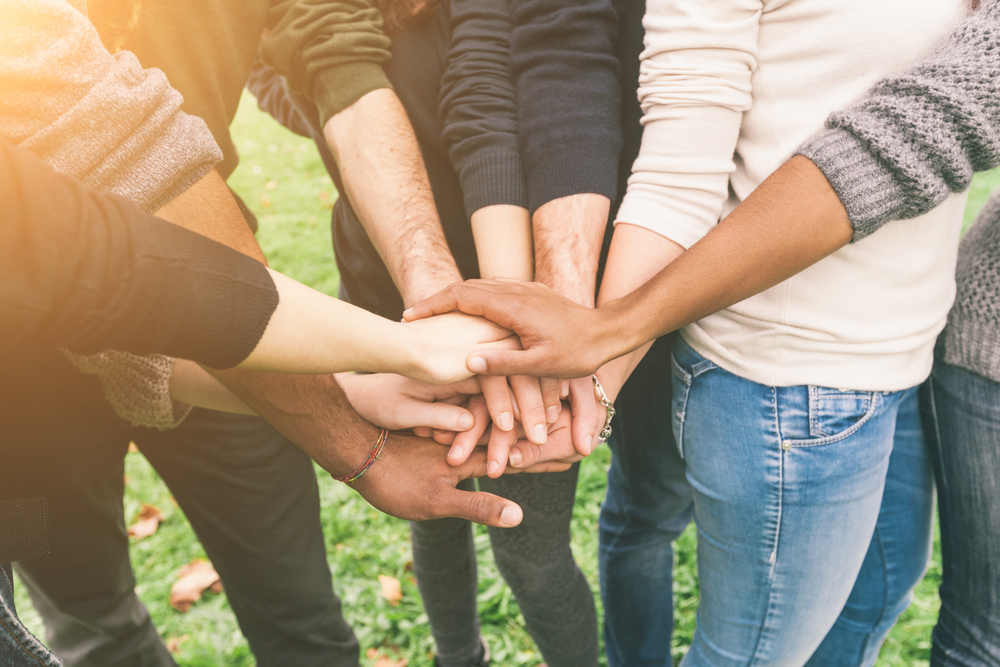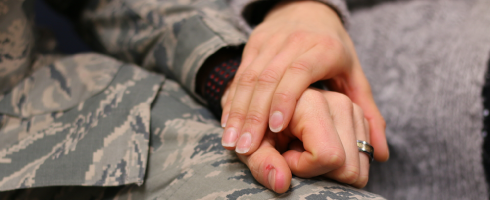
Leaving Behind A Good Example / Dejando Un buen Ejemplo
Waldemar Orozco
10/7/1943 – 1/25/2022
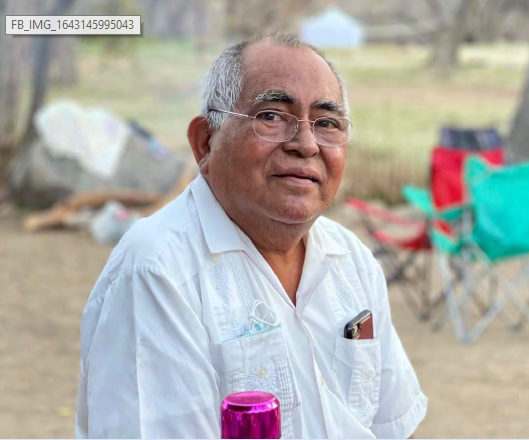
by Elizabeth Gomez, Service area 7 promoter / Promotora de la área de servicio 7
Mr. Waldemar Orozco was originally from Puerto San Jose Guatemala, and he began his career as a Mental Health Promoter in 2011. He participated in the Promoter training and began providing workshops for the LA County Department of Mental health.
Waldemar facilitated presentations in various community settings including schools, parks, senior centers, and churches. He provided workshop participants with knowledge and the message that there are no limitations in life or obstacles that can’t be overcome. He was the best example of this philosophy after having suffered a stroke in 2011 and having to learn how to eat, speak, walk, and write with his left hand.
Waldemar was a Promoter that was dedicated to his work as he approached it with love. All his workshops were different, personalized, and unique. He had a gift at connecting with participants that conveyed trust. He was humble, punctual, respectful, and wise and loved his work. read more…
Native American Gatherings
by Bernice Mascher, co-chair of LACDMH’s Cultural Competency Committee

LACDMH Staff & Community Members celebrate Native American culture with a dance at our Peer Resource Center, 2019
Like so many events in the last two years, COVID-19 canceled most events in the Native American community as well. This includes many of the annual Native American Pow Wows and annual gatherings. Pow Wows occur across the North American continent, as one of the ways the Native American community gets together to renew friendships and build relationship. It’s a time of celebration and renewal as cultural foods are enjoyed (i.e. frybread, Indian tacos), authentic crafts are sold, and the arena brings together dancers, singers, and traditional honorings of many kinds. This is a great way to find community members, and a wonderful way to participate and learn more about the Native American culture. It is also a relaxing way to spend a day.
If you want to learn more about Pow Wows, or if you want to pencil in a visit to an upcoming event, check out https://www.powwows.com. They keep an updated calendar of most events, and they offer plenty of information about Pow Wows for anyone attending for the first time. There are many “community” Pow Wows (often held at schools and parks) as well as large competition Pow Wows (held by most Casinos and Tribes in the surrounding areas and of Southern California). Each event has its own unique sense of atmosphere and excitement, and various activities and a number of vendors. These events are all open to the public, but be aware there are some “rules” and ways to show respect. Don’t be afraid to ask questions once you are there. Also listen closely to the MC giving the announcements in the arena, which will let you know what is going on, including when you can join the dancers in the arena (during “Inter-tribals” only). Be careful with photos. If you want to take a close-up photo of a dancer, ask! Also, do not take photos during the competitions. The MC will let you know ways in which you can participate, and most attendees are very open to have a conversation with you if you are truly interested to learn.
If you have never been to a Pow Wow, or if it’s been a long time since you enjoyed some of the foods or connected with friends, or you just want to experience some of the uniqueness of the Native American culture, here are three near-by opportunities to be involved in the month of April and May: read more…
Celebrating Sexual and Gender Diversity in March
by Rebecca Gitlin, Ph.D. (she/her), Clinical Psychologist & LGBTQ+ Services Specialist
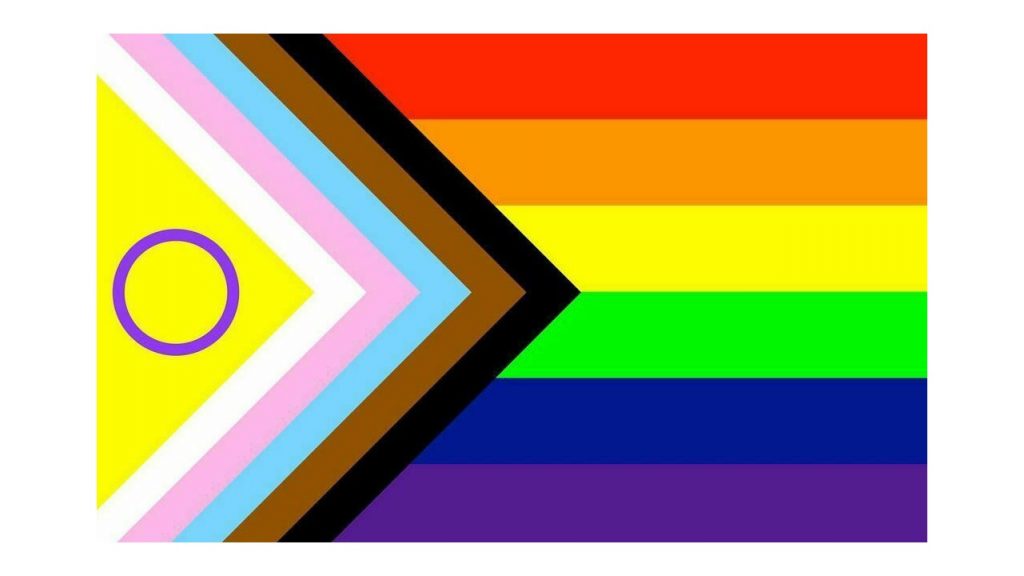 March is an important month for celebrating sexual and gender diversity. Many of us are already aware of Women’s History Month. March is also regarded as Gender Equality Month, which serves as a call to celebrate the history, contributions, and wellness of community members who are impacted by gender-based bias and oppression. We honor and uplift the livelihoods of all femmes, transgender and non-binary people, and women and girls this month and year-round.
March is an important month for celebrating sexual and gender diversity. Many of us are already aware of Women’s History Month. March is also regarded as Gender Equality Month, which serves as a call to celebrate the history, contributions, and wellness of community members who are impacted by gender-based bias and oppression. We honor and uplift the livelihoods of all femmes, transgender and non-binary people, and women and girls this month and year-round.
March is also Bisexual+ Health Awareness Month. While overall health-related inequities among lesbian, gay, bisexual, transgender, queer, intersex, asexual, and Two-Spirit (LGBTQIA2-S) communities are fairly well known, bisexual+ individuals (including those who are bisexual, pansexual, queer, and/or fluid) experience particularly elevated disparities in health outcomes and social determinants. This is related to the invisibility and/or dismissal of bisexual+ identities and lived experience within many communities and spaces in our society, including within healthcare institutions. The theme of Bisexual+ Health Awareness Month 2022 is Connection, which emphasizes the importance of bisexual+ community members’ connecting with each other and with affirming healthcare services.
March 21-25 also marks the 20th National LGBTQ Health Awareness Week. This year’s theme is Live Out Loud for LGBTQ Health and encourages all of us to speak openly about LGBTQIA2-S health, barriers and gaps within our system of care, and community strengths that elevate the wellbeing and beauty of a sexually and gender diverse Los Angeles County.
Finally, March 31 is International Transgender Day of Visibility. Founded in 2009 by Michigan-based transgender activist Rachel Crandall, Transgender Day of Visibility (TDOV) uplifts the livelihood, resilience, and accomplishments of transgender people. TDOV also serves as a call to action to take the necessary steps to foster a safe and affirming world for people of all gender identities. When we celebrate the existence and survival of transgender, gender non-conforming, and intersex (TGI) people, we collectively recognize community members who are often dismissed or rejected. In doing so, we aim to reduce stigma, offer hope, and raise awareness about the lived experiences of TGI people.
As we honor the visibility and awareness of LGBTQIA2-S communities this month, we must also acknowledge that it is not safe for many people to live openly as their authentic selves. Indeed, visibility can be associated with increased vulnerability for many, as community members experience discrimination, harassment, and violence in response to their actual or perceived sexual and/or gender identity. BIPOC transgender women and gender nonconforming people, in particular, are disproportionately targeted in acts of anti-transgender hate and violence.
We know that affirming a person’s authentic identities is itself an effective healing practice that can reduce health disparities and promote community wellbeing. This month and all year, we invite you to join us in transforming our society and healthcare institutions into more welcoming, diverse, and equitable spaces for everyone.
Capitol Crawl to Access for All
By Alex Elliot, Psychiatric Social Worker
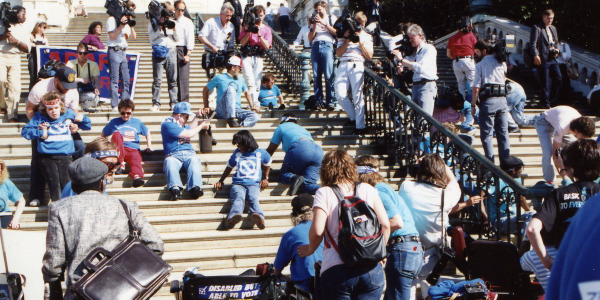
There are many significant cultural moments in March for people with disabilities. I want to highlight one event that had a major impact on many people with disabilities that took place on March 12th, 1990.
I was born without my right forearm or an “ongoing health condition: dysplasia of right arm” according to my health records. When I was a kid there was no internet, I never met anybody else with the same disability that I had. I was only aware of one other person on earth born without a hand: Major league baseball starting pitcher Jim Abbott of the California Angels.
I am lucky to have grown up as part of the “ADA generation”. For almost all my life the Americans with Disabilities Act (ADA) has been a part of federal law. The ADA has played a critical role in supporting programs and services throughout my journey navigating life with a disability. The Disabled Students Program at UC Berkeley provided assistive technologies to support my journey through college. When I started at LACDMH, I was a Master’s in Social Work student at Cal State University, Long Beach enrolled in the Disabled Students Services program and the Vocational Rehabilitation program within the Department of Rehabilitation.
Without the actions that took place on March 12th, 1990 my life could have been a lot different. The “Capitol Crawl” protest for disability rights on March 12, 1990, was a critical event leading to the passage of the ADA.
After months of inaction by Congress; “More than 1,000 protesters came to Washington on that day to urge Congress to approve the law. Calling for immediate action, they chanted “What do we want?” “ADA!” “When do we want it?” “NOW!”…
read more…
Lunar New Year’s Traditions
The holidays is about luck, health, and reuniting with family.
When people talk about the “holiday season” in the U.S., they typically refer to that period between Thanksgiving dinner and New Year’s Day. But shortly after that, another massive holiday brings friends and family together in several Asian countries, with concurrent parties that carry on the traditions stateside. The Lunar New Year, most commonly associated with the Chinese New Year or Spring Festival, typically falls between mid-January and mid-February annually. Lunar New Year 2022 is on February 1, and in terms of the Chinese zodiac animal, it’s the Year of the Tiger.
It’s called the Lunar New Year because it marks the first new moon of the lunisolar calendars traditional to many east Asian countries including China, South Korea, and Vietnam, which are regulated by the cycles of the moon and sun. As the New York Times explains, “a solar year-the time it takes Earth to orbit the sun-lasts around 365 days, while a lunar year, or 12 full cycles of the Moon, is roughly 354 days.” As with the Jewish lunisolar calendar, “a month is still defined by the moon, but an extra month is added periodically to stay close to the solar year.” This is why the new year falls on a different day within that month-long window each year. read more…
Join LACDMH’s Cultural Competency Committee
by Sandra T. Chang, Ph.D., LACDMH, ARDI Division-Cultural Competency Unit
- Is joining a dynamic and productive Committee one of your new year’s resolutions?
- Are you interested in learning about and hearing the voices of different cultures?
- Would you like to be a part of a group that advocates for the mental health needs of different cultural groups?
If you answered “yes” to any of the questions above, seek no more, you have found the Cultural Competency Committee (CCC).
Welcome and best wishes of a healthy and prosperous New Year 2022! The CCC serves as an advisory group for the infusion of cultural competence in all of Los Angeles County Department of Mental Health (LACDMH) operations. Our members represent abounding cultural and linguistic perspectives of consumers, family members, advocates, peers, directly operated and contracted providers, and community-based organizations. Everyone is welcome to the CCC. We meet virtually on the second Wednesday of the month from 1:30 to 3:30 p.m., and the full meeting schedule for 2022 is available here.
CCC Mission Statement, Motto and Logo
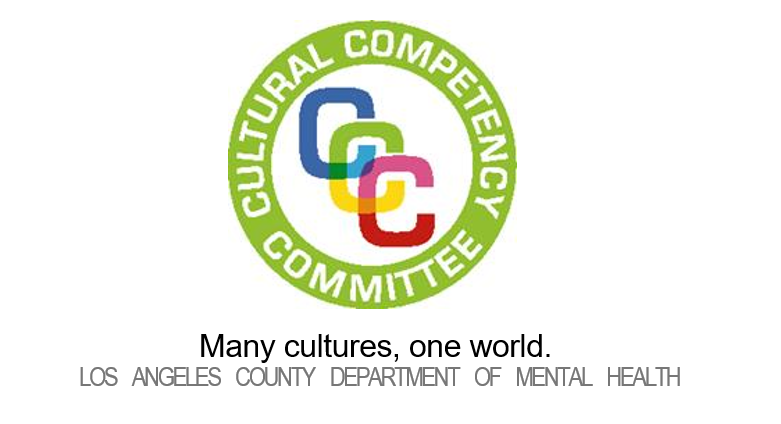
“Increase cultural awareness, sensitivity, and responsiveness in the LACDMH’s response to the needs of diverse cultural populations to foster hope, wellness, resilience, and recovery in our communities.” In recognition of the richness of cultural diversity, the committee’s motto is “Many Cultures, One World.”
The CCC started the new year with Co-Chair elections. Both Co-Chairs come directly from the community. Meet the 2022 CCC Co-Chairs through their own words: read more…
Cultural Traditions & Connections Project
by Sandra T. Chang, Ph.D., LACDMH, ARDI Division-Cultural Competency Unit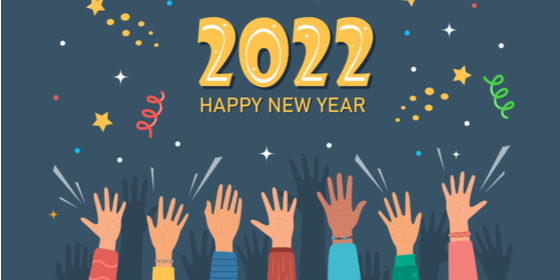
The Cultural Competency Committee, in collaboration with the ARDI Division-Cultural Competency Unit, has started 2022 with a work plan that includes a continued focus on our Cultural Traditions and Connections Column. We look forward to the many insights we will gain, encouragement we will receive, lessons we will learn, and cultural insights we will share that will grow our knowledge and awareness of one another’s unique life experiences. We hope many of you will consider contributing something unique and personal in the coming months.
About our Cultural Traditions and Connections Column
This project is rooted in the Cultural Competency Committee’s (CCC) “Share your Culture” activity, which engaged community members, consumers, family members, peers, and staff in sharing about their cultural background at the time in-person meetings were the norm. With the encroachment of the COVID-19 pandemic, the Cultural Competency Unit in collaboration with the CCC created the online Cultural Traditions and Connections Column as a safe space to share, learn, celebrate, and connect our collective cultural experiences. The Cultural Traditions and Connections column is featured in LACDMH’s monthly “Connecting Our Community Newsletter.”
Our Goal:
- To honor our personal and communal sense of culture through creative writing, photography, reflections, and more. By sharing about our own cultures, we promote cross-cultural learning, understanding, sensitivity, appreciation, and healing for our collective soul.
- To sustain a virtual space in which everyone can discover, learn about, and nurture the richness of our present experiences and ancestral teachings. Reading heartwarming articles and thought-provoking reflections will expand our horizons, relax our weary minds, draw smiles across our faces, enhance our knowledge and deepen our compassion for different ways of living.
Join the Cultural Traditions and Connections Movement
- Do you have a cultural practice or tradition that has influenced you and you want to share with others?
- Do you enjoy writing short stories, anecdotes, poems, reflections?
- Do you have photographs you would like to share?
We would love to feature you in future newsletter issues!
For additional information and to submit content for the column, please contact the Cultural Competency Unit at DMHCC@dmh.lacounty.gov
Military Transition
by James Zenner, Director of LACDMH’s Veteran Peer Access Network (VPAN)
One of the biggest challenges for those who serve is adapting to life after the military. When in the military, there are no decisions to be made about what to wear to work, where to live, or other decisions that you have to make when outside of the military. One of the biggest things you will hear veterans say they miss about the military is the camaraderie and sense of purpose they had while “wearing the uniform.” These are just a couple of examples of what our men and women who serve have to adapt from when exiting the military.
Most of us struggle to find work that provides a fraction of the meaning and camaraderie we had in the military. Veterans often struggle without having the routine and structure of the military, but often cite it as one of the reasons for leaving the service. The majority of those leaving the military don’t have a viable transition plan and some struggle with food and housing insecurity, legal issues, marital and relationship issues, as well as mental health.
The good news is, many veterans are able to have a successful transition out of the military after struggling for a little while. The likelihood of success is considerably diminished without a family or social support system, however. While the Veterans Administration does provide healthcare and benefits for many veterans, that does not constitute the lack of family, social support, and an overall sense of connectedness with the community because many come out of the military seeing themselves, others, and the world differently. It is up to us as a community to pull these men and women into our social fabric and help them feel connected again.
To learn more about the work our department is doing for this effort, visit our VPAN webpage.
What is Culture?
by Lorraine Viade

There are many definitions of the word culture. The free dictionary online offers a myriad of choices. The first refers to the arts, beliefs, customs, institutions, and other products of human work and thought considered as a unit. There are others, but today, I want to focus on the term as it impacts our interactions with other people. Cultural awareness, sensitivity, or humility is to be open and curious about how any definition of culture directly impacts us. We strive to respect the people we work with.
It is essential to know not only if their ancestry, ethnicity, or affiliation falls into one or more cultural groups, but how another person experiences that culture. We also need to know that for ourselves.
There are stereotypes for many cultural groups there is no stereotype that defines any single person. Each person represents a unique constellation of experiences in a specific human being with a unique personality. So, how do we get to know someone’s culture in a respectful and meaningful way?
We become detectives. We want to know the Who, What, When Where, How and Why someone does, says or believes what they do. We maintain a curious, non-judgmental, and objective stance that does not assume that we know anything. We are here to learn about each other and that is where engagement begins. Figuring out our own pre-conceived biases, notions, ideas about a particular culture while enhancing our understanding of the person in front of us is the goal of engagement.
Trust means setting aside what we think we know and learning what we need to know about the people around us. How else can we ever hope to understand anything about them? Listening to someone else’s story, we relate to the things we share, learn about, and celebrate the unique differences, and create new avenues of communication and in that experience, we come to know each other. This is the foundation of health and the soil out of which healing grows. Discovering Who we are—together.
National Hispanic Heritage Month
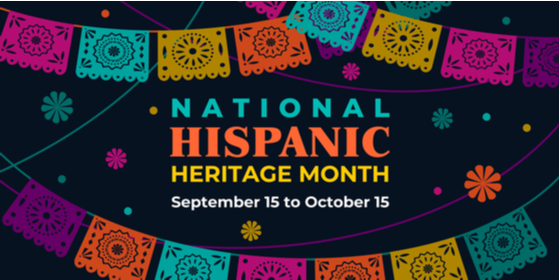
Each year, Americans observe National Hispanic Heritage Month from September 15 to October 15, by celebrating the histories, cultures and contributions of American citizens whose ancestors came from Spain, Mexico, the Caribbean and Central and South America.
The observation started in 1968 as Hispanic Heritage Week under President Lyndon Johnson and was expanded by President Ronald Reagan in 1988 to cover a 30-day period starting on September 15 and ending on October 15. It was enacted into law on August 17, 1988, on the approval of Public Law 100-402.
The day of September 15 is significant because it is the anniversary of independence for Latin American countries Costa Rica, El Salvador, Guatemala, Honduras and Nicaragua. In addition, Mexico and Chile celebrate their independence days on September 16 and September 18, respectively. Also, Indigenous Peoples’ Day (October 11) falls within this 30 day period.
Below is a compilation of on-line articles that highlight interesting facts about Independence Day festivities in the countries mentioned above, courtesy of the Cultural Competency Unit:
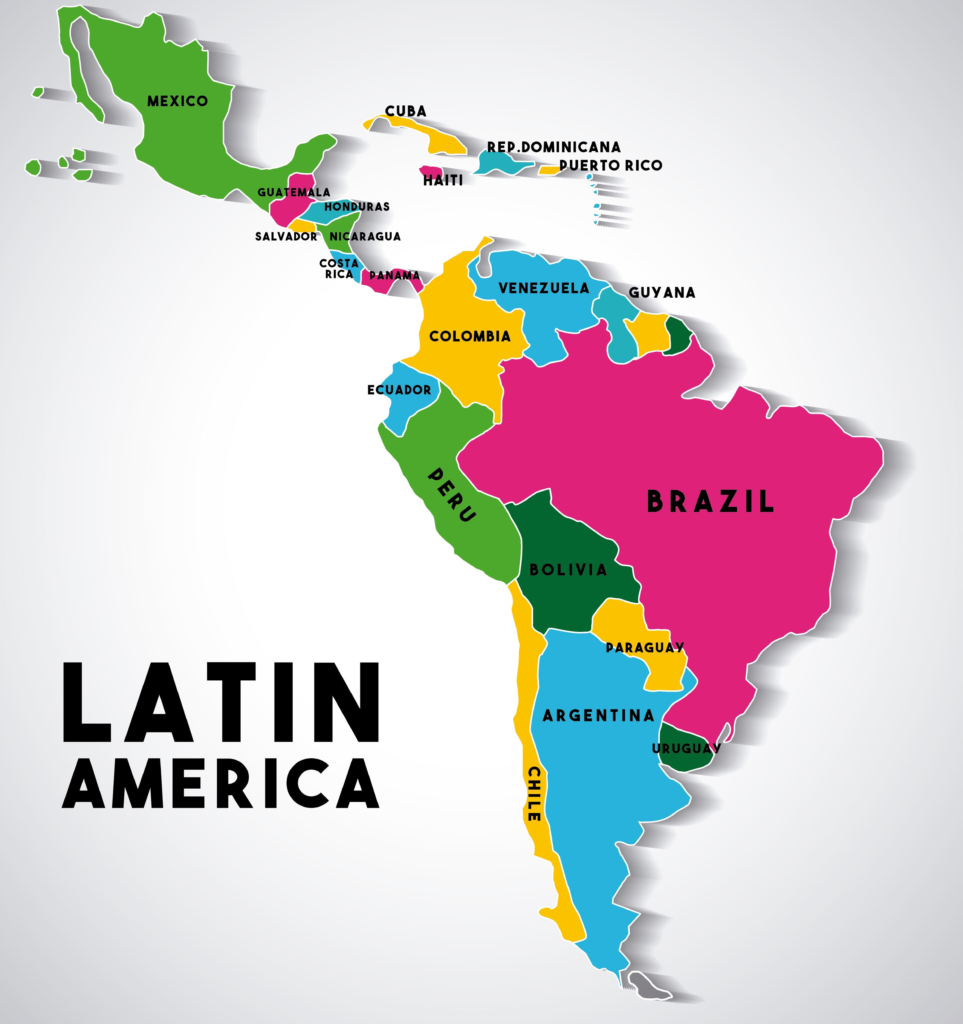
Mexico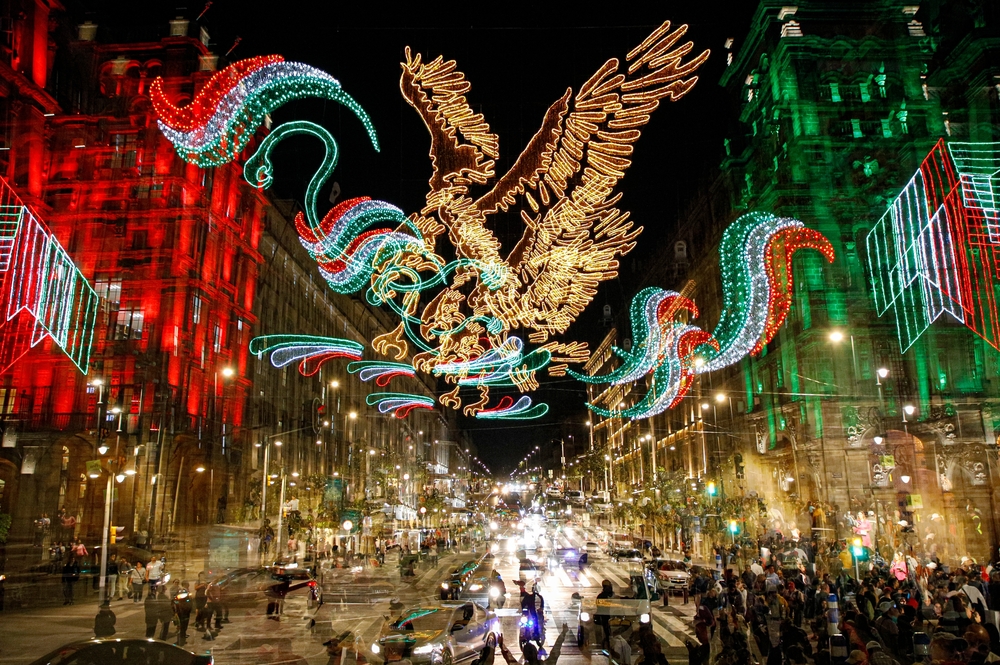
Mexican Independence Day celebrates the beginning of Mexico’s fight for sovereignty.
A pivotal tradition of the holiday is honoring “El Grito de Dolores.” Known colloquially as “El Grito,” it’s the famous battle cry from September 15, 1810 uttered by Miguel Hidalgo that kicked off the War for Independence. Hidalgo, who resided in the city of Dolores famously took up the banner of the Virgin of Guadalupe, Mexico’s patron saint, inspiring many to follow him and begin the fight for independence in earnest.
Though Hidalgo’s attempt at a revolution was unsuccessful, it inspired another priest, José María Morelos, to create a more cohesive, prepared fighting force with the same goal. With the help of Agustín de Iturbide, a Mexican military leader who defected from Spain, the freedom fighters took Mexico City in February 1821 and declared national independence
The holiday’s traditions include fireworks and folk dancing.
Independence Day in Mexico is celebrated with huge street parties, parades, and everything from fireworks to rodeos to brass band and mariachi performances and traditional folk dancing in the streets (bailes folclóricos). In Mexico City, there’s a military march that proceeds to the memorial of Hidalgo.
On the evening of September 15, the Mexican president recreates “El Grito” in front of a crowd of hundreds of thousands from the balcony of the National Palace. After each line, the audience chimes in with a spirited “Viva!” culminating in the president ringing a bell as another tribute to Hidalgo.
Signature dishes are essential parts of the celebration.
Foods that are traditionally made for Mexican Independence Day include pozole, menudo, birria de borrego (spiced lamb) …
There are plenty of ways to celebrate Mexican Independence Day outside of Mexico.
Independence Day is widely celebrated beyond Mexico’s borders, with parades and festivals taking place in heavily Mexican cities like Los Angeles, Houston, Chicago, and New York.
El Salvador

September 15, 2021 marked the 200th anniversary of independence for El Salvador from Spain in 1821. It is common to see posters, billboards and Independence Day decorations around town. School-aged children enjoy civic lessons based on history. Parents revisit their own childhood experiences as they assist their children in the production of scrapbooks, essays, and theatrical role plays that focus on national heroes and their contribution to El Salvador’s independence. Whether small or large, schools take pride in their independence day events. Children also rehearse singing the national anthem and reciting the “Oración a la Bandera”/ Prayer to the Salvadoran Flag.
ORACIÓN A LA BANDERA SALVADOREÑA
Autor: Dr. David Joaquín Guzmán
“Dios te salve, Patria Sagrada,
en tu seno hemos nacido y amado,
eres el aire que respiramos,
la tierra que nos sustenta,
la familia que amamos,
la libertad que nos defiende,
la religión que nos consuela.
Tú tienes nuestros hogares queridos,
fértiles campiñas,
ríos majestuosos,
soberbios volcanes,
apacibles lagos,
cielos de púrpura y oro.
En tus campos ondulan doradas espigas,
en tus talleres vibran los motores,
chisporrotean los yunques,
surgen las bellezas del arte.
Patria,
en tu lengua armoniosa
pedimos a la Providencia que te ampare,
que abra nuestra alma al resplandor del cielo,
grabe en ella dulce afecto al Maestro y a la Escuela
y nos infunda tu santo amor.
Patria,
tu historia,
blasón de héroes y mártires,
reseña virtudes y anhelos;
tú reverencias el Acta que consagró la soberanía nacional
y marcas la senda florida
en que la Justicia y la Libertad nos lleven hacia Dios.
¡Bandera de la Patria,
símbolo sagrado de El Salvador,
te saludan reverentes las nuevas generaciones!
Para ti el sol vivificante de nuestras glorias,
los himnos del patriotismo,
los laureles de los héroes.
Para ti el respeto de los pueblos
y la corona de amor
que hoy ceñimos a tus inmortales sienes.
English translation
Translation Source: Sandra T. Chang, Cultural Competency Unit, Speakers Bureau
God keep you, Sacred Homeland,
in your bosom we were born and loved;
you are the air that we breathe,
the land that sustains us,
the family that we love,
the freedom that defends us,
the religion that comforts us.
You hold our beloved homes,
fertile countryside,
majestic rivers,
magnificent volcanoes,
placid lakes,
skies of purple and gold.
In your fields undulate golden spikes,
in your workshops engines vibrate,
anvils sizzle,
the beauties of art arise.
Homeland,
in your harmonious language
we pray to [Divine] Providence to safeguard you,
to open our soul to the radience of the sky,
to engrave in it a sweet affection for teachers and school
and to infuse in us your holy love.
Homeland,
your history,
coat of arms of heroes and martyrs,
critique of virtues and aspirations;
You reverence the Act that consecrated national sovereignty
and you mark the flowery trail
in which Justice and Freedom lead us toward God.
Flag of the Homeland,
sacred symbol of El Salvador,
new generations greet you reverently!
For you, the life-giving sun of our glories,
the anthems of patriotism,
the laurels of heroes.
For you, the respect of nations
and the crown of love
that today we bind tightly to your immortal temples.
Costa Rica

Costa Rica shares September 15 as Independence Day with Guatemala having been deemed a part of the kingdom of Guatemala at the time of the Independence declaration. Though the Costa Ricans did not receive the news until nearly a month later, their independence is celebrated on September 15 with great fun and excitement.
The celebration begins on September 14 with their participation in the annual running of the Antorcha de la Independencia (“running of the torch”) relay. Every year, on the night of 14th September, a symbolic torch of independence arrives from Guatemala to Cartago, the capital of colonial Costa Rica. This is to commemorate the arrival of news of independence via the messenger from Guatemala in 1821. The school children also perform a similar act on 14th September evening. In honor of that torch, they carry paper lanterns that they made in the shapes of houses and other traditional objects. This walk in the evening is called Desfile de Faroles, that is, lantern parade.
On September 15th, there is parade complete with school marching bands and children in colorful traditional dress. The national anthem is broadcast nationwide at 6 o’clock for the entire country to join in singing followed by more parades with participants carrying homemade torches. People of all ages, from small kids to senior citizens, come together to participate. They walk to the rhythm of the music played on their traditional musical instruments. Many people gather on the streets to watch this celebration of Costa Rica Independence Day. The day is filled with joyous celebration for Costa Ricans and visitors including music, dancing, and delectable dishes like “arroz con pollo”, “tamales”, and “tres leches” cakes. People wear traditional costumes and eat traditional food, and share happy times with their family and friends. It is the day for people to flaunt red, blue and white, the colors of the Costa Rican flag.
Guatemala

After nearly 300 years of Spanish rule, the citizens of Guatemala pronounced their independence from the Kingdom of Spain on September 15, 1821. Not to be discouraged by two previous failed attempts put down by Captain General José de Bustamante, Guatemala gained independence with little bloodshed. Today, Guatemalans prepare for their Independence Day celebrations well in advance of the September 15 as decorations appear, students practice the national anthem, and the Guatemalan Army prepares for parades and air shows.
When the day finally arrives, the anticipation spills into the streets – complete with traditional dancing, colorful costumes, spicy tamales, parades, and fireworks. Citizens and visitors alike revel in the infectious festivities and lively entertainment. In celebrating independence, Guatemala is joined by other Central American countries including Costa Rica, El Salvador, Honduras, and Nicaragua on September 15 with the annual Antorcha de la Independencia (“running of the torch”) relay from Guatemala City, through towns and villages to Cartago, Costa Rica. The tradition dates to September 14, 1821, when María Dolores Bedoya ran through the Guatemalan streets carrying her lantern as a symbol of hope for the liberated nations.
The Guatemalan flag features two horizontal blue stripes on the outer edges. These stripes are meant to represent that the nation is locked between the Pacific Ocean and the Atlantic Ocean. The color of the stripes also represents the sky over the nation. The middle stripe represents peace and purity.
Nicaragua
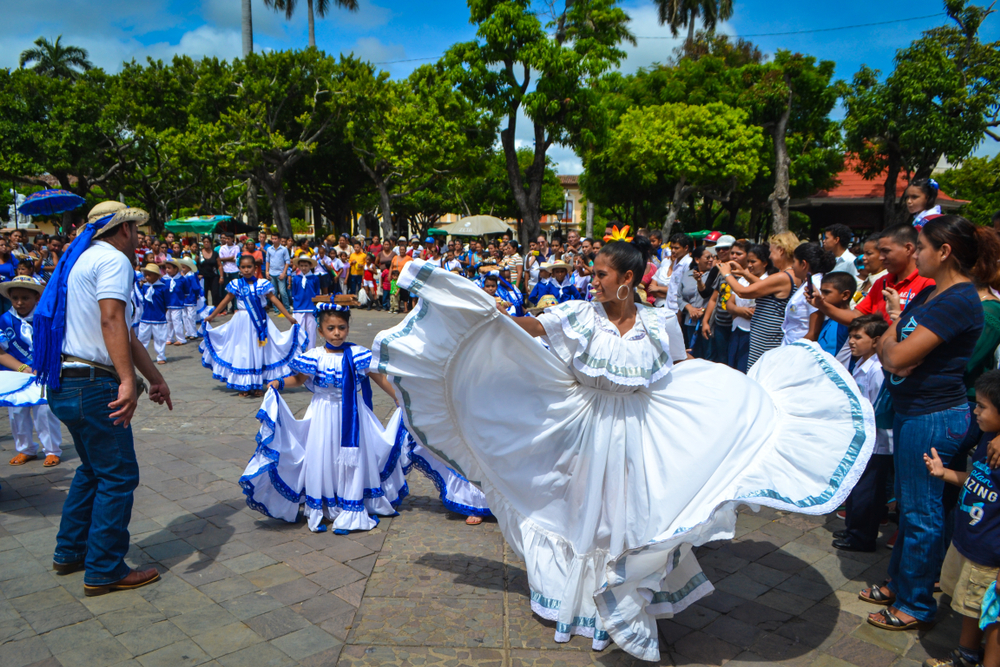
September is celebrated as a patrimonial month, and throughout whole Nicaragua people hang out the blue and white flags at their houses. The commemorative activities start at schools and institutions the first of the month. Below follows a chronological overview of the activities.
September 1 – start of the Central American Patrimonial Festivities, initiated by an act of inauguration. Place and exact date vary every year (generally September 1, though). Besides officials from the Nicaraguan government, ambassadors from the Central American sister republics also participate, as well as hundreds of students from the capital. Schools participate with their marching bands.
September 11 – every year, during the patrimonial month, a burning torch travels through Central America, from Guatemala to Costa Rica, transported by feet and going from hand to hand in every one of the countries. The torch reaches “Las Manos”, the Nicaraguan border with Honduras, on September 11, and is exchanged between the ministers of Education from Honduras and Nicaragua (in the morning). The torch then starts to travel the country over the Pan American Highway, and it goes from hand to hand by the best students from the schools of each municipality and other outstanding individuals who will each run with the torch for no more than 100 meters. The total run is 387 kilometers and it involves more than 8 thousand students.
September 12 – this day, at 9 AM, the torch is received, generally at the National Cultural Palace, by the President of the republic or by the Minister of Education accompanied by other government officials. Folkloric events take place in the morning as well.
September 13 – at the southern border ‘Peñas Blancas’ the torch changes hands between the Nicaraguan and Costa Rican Ministers of Education. This day, at 6 PM, the national flag will be hung out in all educational centers and principal institutions. Furthermore, the national anthem is broadcasted in the media and performed throughout the country.
September 14 – at 6 AM the flag is once more hung out commemorating the anniversary of the independence of Central America and the battle at San Jacinto. This day the central act takes place, starting in the morning and led generally by the President of the Republic. Several years ago, the act took place at the National Stadium, but this limited the number of spectators. In the past years the event therefore took place around the Masaya Highway or in the old center of Managua. During this event, the Presidential Medallion is awarded to the best students and teachers from the country. Furthermore, a parade is formed by 100 schools from the capital (approximately 15,000 students) with the marching bands as well as bands from the National Army and the Police.
September 15 – the Act of Independence of Central America is read in all state schools throughout Nicaragua, in an act of commemoration. This final event ends the series of activities related to the battle at Hacienda San Jacinto and the Nicaraguan independence. Part of the celebrations consisted in the past years also of the ‘Festival Nacional de Bandas Rítmicas’, generally celebrated during the first days of September. These activities now take place on different dates throughout the year, during other months than September. These bands are groups that combine music and choreographic rhythms, composed of students from schools from throughout Nicaragua. Every group represents its school and is selected during departmental contests. The groups compete in front of a juror who will choose the best musical group of the country. The finale of the festival takes place at the National Stadium in Managua, and is open to the public.
In case you are wondering, Panama’s independence festivals are celebrated in November, from the 3rd to the 10th.
Chile

What is “Fiestas Patrias”/ Patriotic Festivities to Chile?
Fiestas Patrias – otherwise known as “dieciocho” – is the celebration of Chile’s independence from Spain in 1810, and the 18th and 19th of September – which commemorate the first day that the Chilean government gathered to declare independence from Spain, as well as the Day of the Glories of the Army – are the best holidays in the whole country, eagerly awaited year round. Imagine if Christmas, your birthday, and the fervent pride of your country’s independence day were all rolled into one giddy, ecstatic party: THAT is the level of Fiestas Patrias in Chile.
Although the official holidays are Sept. 18th and 19th, most schools and businesses offer extended vacation days so the country can relax and enjoy the fun, and many people take the whole week off work to travel, be with family, and have a grand old time. As the whole country celebrates, there is an overload of food, music, dance, art, and joy, making it arguably the best time to come and experience the true character and flavors of Chile.
- Authentic and delicious food – Chileans go all out when it comes to the food and drink for their independence day celebrations, and everything is delicious and wholly Chilean. …enjoy empanadas de pino, sopaipillas, as sopaipillas pasadas… Chileans love a good barbecue so for Fiestas Patrias you can find everything from standard cuts of chicken, beef, and pork, to anticuchos (meat skewers) and choripan (chorizo sandwiches).
- The best party drinks – For wine, try melon con vino, which is chilled white wine and powdered sugar served in a hollowed out melon, or pipeno, a super-sweet wine that is used in terremotos, an insidious drink made with pipeno wine, Fernet, and ice cream… Yet another popular drink is chicha, a liqueur-type aperitif that’s very sweet and is distilled from grapes or apples.
- Wonderful music and dance – The Fiestas Patrias parties is the best place to get your groove on! Bands play traditional Chilean music and songs, dancers wear traditional garb like large-skirted dresses and huaso (cowboy gear), and it’s one of the best times of the year to see Chileans dancing their national dance, the cueca.
- Party at different venues to see how the country celebrates – You can celebrate Fiestas Patrias at the home of any Chilean or in restaurants, but the best place to get the true ‘dieciocho’ experience is at a fonda.
- Experience the sense of national pride and comradery – The celebration of the start of their fight for independence is something unites the whole country of Chile, and it’s wonderful to watch the whole country getting excited and celebrating together. From the beginning of September, flags start flying and people start gearing up for the big day, and being a part of all that excitement and joy, like the whole country is having one big giant party is a feeling that’s hard to find anywhere else.
Blog Search
About This Blog
The project has its roots in the Cultural Competency Committee’s “Share your Culture” initiative introduced by Co-Chairs, Mr. Sunnie Whipple and Ms. Bernice Mascher. This initiative engaged community members, consumers, family members, peers and staff alike in presenting on different aspects of their culture; thereby fostering cross-cultural learning, understanding, sensitivity, and appreciation.
The Cultural Traditions and Connections Blog came out of the need to connect with our committee members, inclusive of consumers, family members, peers, advocates, community members, colleagues and co-workers. It was fueled by the need to tell everyone that we care about what is happening within our families, our neighborhoods, our communities, our country, and our world.
We can all share and find nurturing connections by engaging in reading heartwarming articles and reflections that help us relax our tired minds, draw smiles across our faces, and comfort our spirits with a sense of collective caring found in the richness of who we are as human beings.
This blog’s content is managed by the members and staff of the Cultural Competency Committee.


